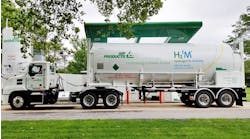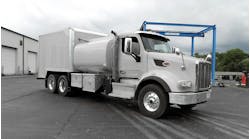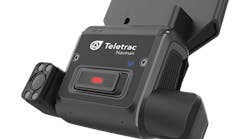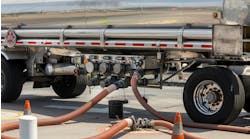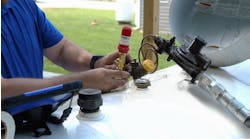One of the most celebrated trophies in trucking toured the states this summer.
Service Transport Company president Wade Harrison wanted everyone who helped the company capture its first Heil Trophy in National Tank Truck Carriers’ 2021 North American Safety Contest to share in the rewards, so the trophy visited various terminals, where drivers, dispatchers, mechanics, and others could admire it at safety meetings—or take it to local landmarks, like the Gateway Arch in St. Louis, Missouri, for epic selfies.
“It’s not fair for only the folks at the corporate office in Houston to enjoy it,” said Mike Leggio, senior vice president of operations at Adams Resources and Energy, Service Transport’s parent. “It takes everybody in the company to make this work.”
Marty Avinger, who manages the Houston terminal, which also is Service Transport’s busiest location, was happy to share, for a while. But he was happier when the tank truck industry’s version of the Vince Lombardi Trophy returned home to Texas, safely intact. “I tell everyone it’s my trophy,” Avinger joked.
“I’ve got 30% of the drivers—so I get at least 30% of the trophy.”
The for-hire bulk hauler clinched the Heil, aka the Outstanding Performance Trophy, with a .358 accident frequency in the Harvison division for carriers whose trucks traveled more than 15 million miles last year. Service Transport qualified for the honor by winning a Grand Award in the 18.5-31.5 million-miles division.
Everyone involved credited inspired leadership—from Adams president and CEO Kevin Roycraft to a talented team of safety directors, terminal managers, and driver trainers—for Service Transport’s safety success, along with a rigorous training program, and its commitment to running elite equipment. And because safety and good business go hand in hand, prizes include imposing hardware—and exceptional expansion.
See also: Service Transport, Lacy's Express capture safety championships
After generating $55 million in revenue four years ago, Service Transport is on track to reach $114 million this year, despite recent challenges, including a pandemic, a deadly freeze in Texas, and historic inflation. “The company’s growth is quite amazing,” said Mike Lundberg, vice president of sales and marketing at Service Transport.
Growth-oriented operation
Harrison, who joined the company in 2018, credits customer and product diversification for the company’s advancement. “When I came in, we had one customer that was 65% to 75% of our business, and we primarily handled three products [methylene diphenyl diisocyanates (MDIs), acrylics, and latex],” Harrison said. “Now, by growing and diversifying, no single customer accounts for more than 25% of our business, and no product exceeds 15% of our commodity mix.”
Recent acquisitions accelerated Service’s growth. It added Houston-based EH Transport in 2019 in a move that broadened its product-handling portfolio beyond general chemicals, and it absorbed Florida-based CTL Transportation—where Harrison spent seven years as VP of national accounts—in a transaction that bolstered its North American footprint and customer base, and generated new peroxide and acid business. Service now hauls “significant” quantities of 20 to 25 commodities—and more than 1,000 total products.
“We’re not a one-dimensional carrier anymore,” Lundberg said. “We’re moving everything from general chemicals to specialized products, asphalt, dry bulk, acids—you name it, we handle it.”
The company founded in 1965 as a petroleum transporter now has 20 locations spread across the country after opening a terminal in September in Pennsylvania. Service had only six terminals when Roycraft convinced Harrison to help him revitalize their operations. It also now boasts more than 360 drivers, including 270 company drivers and 90 owner-operators, after adding more than 100 in the last four years.
“The good thing about our company is we’ve got great support from Adams, we’ve got our sister company, GulfMark [Energy], so we have good balance, and we’ve got a fantastic board of directors that supports us from a financial standpoint, so we can ride out the lows better than companies similar to our size,” Harrison explained.
Lundberg said they also picked up 30 customers in the last 18 months as undersupported carriers struggled to meet shipper demands, due in large part to a driver shortage exacerbated by the pandemic. “That opened new avenues for us to show our talent and strengths with companies we’ve never done business with before,” he said, adding that going after more driver-friendly business is bolstering growth, too.
Fresh perspectives
Service’s driver-centric approach, built around a culture of safety and reinforced by thoughtful expansion, is the foundation for a new management style Nolan Everitt, regional operations manager for Texas, says is responsible for their exponential growth—and emergence as an NTTC safety champion. “If you’re not growing, you’re dying, and I’ve been in this business a long time,” said Everitt, who spent 17 years with Enterprise Transportation before joining Service in 2015. “So it’s nice to see the company flourishing.”
Avinger, who estimated he’s dispatching 300-plus loads per week in Houston—despite accepting only a third of the loads they’re offered—has been with Service for more than a decade. He says Adams’ board has “gone out of its way to hire some of the best people in the industry,” and their efforts are paying dividends. “It was refreshing when we brought in all these guys,” Avinger said. “Now we have a direction.”
Roycraft worked with recent Heil winner Dana Companies before landing at Service in 2017, and rising to Adams CEO in January 2020. Harrison spent more than eight years with eight-time Heil Trophy winner Groendyke Transport, Lundberg served for 17 years at Superior Carriers, where he was part of an NTTC safety championship in 2014, and Leggio also came from Enterprise.
“We brought a lot of talented people into the company, and that really elevated our operations,” Lundberg said. Harrison agreed, saying the influx of fresh perspectives sparked innovative approaches to familiar issues. “Service has always been a great company with excellent people and service, but many of those people had only worked for Service,” he said. “By adding team members from other outstanding organizations, we brought in new ideas and ways of doing things, and that propelled us forward.”
Personal touch
Importantly, they “all believe in the same principles,” Lundberg said.
Universal tenets include approachability, clear communication, and chasing the Heil Trophy, which Harrison said was ingrained in him at Groendyke. “There are a lot of ancillary benefits for winning an award like that,” he said.
Accessibility is underscored by Service’s Lunch with Leadership, a program in which everyone from Adams chairman Townes Pressler to Roycraft, Harrison, and key managers, sit down with every new hire. “We talk to all of them, and explain how important safety is to our company,” Leggio said. “We’re a publicly traded company, and they’re hearing that from our chairman of the board and CEO. That resonates with people.”
So does Harrison’s commitment to attending every safety meeting, Everitt emphasized.
“He’s personally involved, and I love that,” he said. “It’s one thing to hear it from the safety guys, but when the president takes the time to make it to your meetings, and stay actively involved, it means the world.” It also lets drivers know they’re “not out there by themselves,” Avinger said, adding that one-on-one communication is supported by regular newsletters, emails, and texts, so drivers always know what’s happening.
And when drivers feel safe and supported, they let other drivers know, too.
“It’s not the company you work for, it’s the people you work for that is important, and if drivers feel comfortable with the people, and they like who they work for, they’ll stick around a lot longer,” Avinger asserted.
Well-deserved recognition
While Service’s drivers remain their best recruiters, the Heil Trophy is an effective tool that draws industry-wide recognition. That’s why it was important to Harrison to simply compete for the award, which wasn’t always a priority for the company. “I wanted to put Service on the map,” he said. “Service has always been a fantastic company. Customers appreciate their service, and the safety metrics are great.
“But nobody knew about it because they never applied.”
They finally did two years ago, and then won this year in a spectacular ascent even Service’s safety director found hard to believe. “I was saying the company’s name in my head but was caught off guard when I heard it,” recalled Bill Hartt, who attended the award ceremony in April. “I thought, ‘Wait, did he say Service Transport, or was I thinking it really loud?” Then he saw everyone at his table stand and clap, and knew it was real.
“Our drivers deserved it,” Hartt said. “It’s not anything I did.”
Service drivers covered almost 28 million miles with only three preventable accidents in 2021. They boasted low Compliance, Safety, Accountability (CSA) scores across the seven BASICs (Behavior Analysis and Safety Improvement Categories), including 0% in Driver Fitness and Controlled Substances, 3% in Unsafe Driving, and 13% in Crash Indicator; and Service also posted an OSHA Total Recordable Incident Rate of 1.43% in 2021.
“Winning shows the industry we’re doing what we say we’re doing, and we care about the right things,” Hartt said. “And even if you don’t win, the application might reveal a weakness you have, and you can correct it.” Lundberg suggests securing the Heil further “elevated” their reputation. “It catapulted us in a different direction, especially in conversations with drivers and customers, and even vendors. In fact, we landed a large customer [because] their key component was safety, and winning the Heil opened their eyes to who we are.”
Service’s customers benefit, too. “Along with all our employees relishing in the win, we put it out there to our customers, and they can go sell that to their customers, and say, ‘Our product is shipping with one of the safest companies out there,’” Leggio said. “‘As a matter of fact, they just won the Heil Trophy.’”
Home-grown talent
Hartt and Avinger both joined Service straight out of driving school.
For Hartt, it was the only option. “Being 24 years old, Service Transport was the only company that would talk to me,” he said. “Everybody else wanted me to be 25.” Avinger was older when he joined the company after 20 years in the foodservice industry, but he didn’t have any trucking experience. Service gave him an opportunity anyway. “I appreciated it because a lot of companies won’t touch students,” Avinger said.
“I had my Class A CDL and my tanker endorsement, so I was fully certified, and I could do the job, I just needed a chance.”
Service can provide those opportunities because of its “strenuous” screening process, and “phenomenal” training program, leaders agreed.
Hands-on training typically lasts four to six weeks, Hartt said. One week of orientation in Houston includes three days of classroom instruction with training director Vito Fruggiero, one day of Smith System driver training, and one day in the yard learning about the myriad trailers and equipment in the fleet, and loading and unloading water in simulated transfers between trailers and stationary tanks. Service uses J.J. Keller training modules in the classroom and makes videos easily accessible for on-road refreshers.
Engaging novice drivers is “an expensive part of our recruiting efforts, because they go through the student driving program, and then could be with a driver trainer another six to 10 weeks, depending on how quickly they catch on,” Harrison said. “But we don’t rush them. It takes as long as it takes, and when they’re ready, we cut them loose.” That patient, home-grown approach builds loyalty, Avinger said, and Leggio contends their investment is invaluable because they show drivers the “correct way” to operate. For Hartt, it’s the best way to go, too. “Even as a driver trainer, I’d rather have somebody straight out of school than somebody who’s been driving, because it’s easier to build good habits than it is to break them,” he said.
Greenhorns start with general chemicals. Specialized freight still requires experience, Leggio said. Service training emphasizes pre- and post-trip inspections, and product knowledge, and ongoing reinforcement keeps safety top of mind. “Every driver attends a safety meeting every quarter, and they also recertify on the products they haul every year,” Avinger said. All drivers enjoy stop-work authority, and they’re issued complete sets of personal protective equipment (PPE), including steel-toed boots, chemical splash suit, hard hat, safety glasses, ear plugs, and face shield, that they’re encouraged to wear at all times, even when handling non-hazardous materials, so they’re “not lulled into a false sense of security,” Hartt said.
Finally, Service awards safety bonuses worth up to 11 cents a mile quarterly. Company drivers are paid by the mile, owner-operators by percentage, and rates are adjusted regularly. “We have a great group of drivers,” Hartt insisted. “They’re conscientious, and good, quality people who want to be safe. They care about it.
“And the training we provide finetunes them until they’re elite professionals.”
‘Aggressive’ safety specs
Safety training is supported by advanced safety equipment.
The Service fleet includes 270 company-owned tractors and more than 800 trailers (with 40 more expected by year’s end), including 594 gen-chem trailers, 94 for MDIs and tolulene diisocyanates (TDIs), and 36 for acrylic acid. Service also has Polar and Brenner tank trailers for asphalt, crude oil, sulfuric acid, liquid propane, bleach (FRP trailers), and dry bulk.
Service tractors primarily are Freightliners and Macks. New 2023 Mack Anthems, sourced from Vanguard Truck Centers, feature Bendix Wingman Fusion driver assistance, following distance alerts, lane departure warning, enhanced collision mitigation, air disc brakes on the front and rear axles, roll stability control, automatic traction control, LED headlights, and more. They also come equipped with Paragon HydraChem Auxiliary pumping systems and in-transit heat. “We spec our trucks aggressively on the safety side,” Leggio said. “So if they’re selling it, and we find it’s beneficial, we’re putting it in that truck.”
Everyone deemed forward collision mitigation the most impactful new safety technology. It prevents accidents, and is an effective training tool. “The only way to stop it from beeping is to back off the car in front of you,” Hartt said. “It gets annoying quickly, so drivers back off instead of tolerating the noise.” All company and owner-operator trucks also boast artificial intelligence (AI)-powered idrive systems with forward- and driver-facing cameras. Videos, including driver-facing with permission, are used for training and coaching.
Younger drivers appreciate “new toys,” Harrison said, and “driving new equipment keeps drivers’ morale up,” Everitt added, so Service continually is upgrading its equipment. However, supply-chain disruptions currently are forcing the company to run tractors beyond its preferred five-year trade cycle. “It is what it is,” said Harrison, crediting maintenance for keeping the trucks up and running. “There isn’t much we can do.”
Repeat business
While awaiting the 20 new Macks and 15 Freightliners, Harrison already was planning next steps for Service Transport, including booking next year’s equipment orders, eying further growth—and pursuing another safety championship.
The greatest challenge, for Service and most tank fleets, remains finding drivers.
Through enthusiastic referrals and rookie recruiting, Everitt expected to eclipse 120 drivers at the Houston terminal by the end of the year, but he said he could put another 100 on the road in Texas today. “Hopefully, we can double ourselves again in four years,” Harrison said. “But we’ll definitely have to add an acquisition to do that. We can’t do it organically. The driver market is too tough. So we’ll see what the future holds.”
He’s hoping it also includes taking the Heil Trophy on another national tour. But they’ll first need to secure a second trophy, because Avinger is unlikely to let this one out of his sight again. “As long as we keep putting up solid numbers, win or lose, I’ll be happy,” Harrison concluded. “That means we’re doing the right things when nobody’s looking.
“So we’re going to continue applying for it—and hopefully our numbers are respectable enough to where we’re always in the running.”
